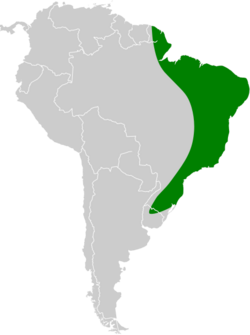Biology:Big red bat
| Big red bat | |
|---|---|
| Scientific classification | |
| Domain: | Eukaryota |
| Kingdom: | Animalia |
| Phylum: | Chordata |
| Class: | Mammalia |
| Order: | Chiroptera |
| Family: | Vespertilionidae |
| Genus: | Lasiurus |
| Species: | L. egregius
|
| Binomial name | |
| Lasiurus egregius (Peters, 1870)
| |

| |
| Synonyms | |
| |
The big red bat (Lasiurus egregius) is a species of vesper bat from South and Central America.
Taxonomy
It was described as a new species in 1870 by German naturalist Wilhelm Peters. Peters placed it in the now-defunct genus Atalpha, with a binomial of Atalpha egregia.[2] The holotype was collected in the Brazil ian state of Santa Catarina[2] by Hermann Burmeister.[3]
Description
It has black flight membranes and its fur is a consistent shade of red over its entire body.[4] Two individuals captured in Honduras had forearm lengths of 50–51 mm (2.0–2.0 in) and body weights of 16–17 g (0.56–0.60 oz). Its ear length is approximately 18 mm (0.71 in).[5] Its wingspan is approximately 390.3 mm (15.37 in).[6]
Range and habitat
The big red bat is found in Central and South America. Its range includes Panama, Brazil , French Guiana,[1] and Suriname.[6] In 1998, the species was documented in Honduras for the first time. This marked a 1,200 km (750 mi) extension of the species' range from the previously known northern limit.[5]
Conservation
This species is infrequently encountered. The capture of two individuals in Honduras in 1998 marked the fifth and sixth individuals ever documented.[5] Due to the lack of information on its ecology, geographic extent, population size, and threats it faces, the IUCN lists this species as data deficient as of 2016.[1]
References
- ↑ 1.0 1.1 1.2 Sampaio, E.; Lim, B.; Peters, S.; Samudio Jr., R.; Pino, J. (2016). "Lasiurus egregius". The IUCN Red List of Threatened Species 2016: e.T11351A22119870. doi:10.2305/IUCN.UK.2016-2.RLTS.T11351A22119870.en.
- ↑ 2.0 2.1 Peters, W. (1870). "Hr. W. Peters legte eine monographische Übersicht der Chiroptera Gattungen Nycteris und Atalpha vor." (in German). Monatsberichte der Königlichen Preussische Akademie des Wissenschaften zu Berlin 1870: 912–914. https://biodiversitylibrary.org/page/42381873.
- ↑ Carter, D. C.; Dolan, P. G. (1978). "Catalogue of type specimens of neotropical bats in selected European museums". Special Publications of the Museum: Texas Tech University 15: 82. https://biodiversitylibrary.org/page/55014343.
- ↑ Gardner, A. L. (2008). Mammals of South America, Volume 1: Marsupials, Xenarthrans, Shrews, and Bats. 1. University of Chicago Press. p. 458–467. ISBN 978-0226282428.
- ↑ 5.0 5.1 5.2 Mora, José M. (2012). "Big Red Bat Lasiurus egregius(Vespertilionidae) in Honduras". The Southwestern Naturalist 57: 104–105. doi:10.1894/0038-4909-57.1.104.
- ↑ 6.0 6.1 López-Baucells, Adrià; Rocha, Ricardo; Fernández-Arellano, Gilberto; Bobrowiec, Paulo Estefano D.; Palmeirim, Jorge M.; Meyer, Christoph F. J. (2014). "Echolocation of the big red bat Lasiurus egregius(Chiroptera: Vespertilionidae) and first record from the Central Brazilian Amazon". Studies on Neotropical Fauna and Environment 49: 18–25. doi:10.1080/01650521.2014.907600.
External links
Wikidata ☰ Q305703 entry
 |


